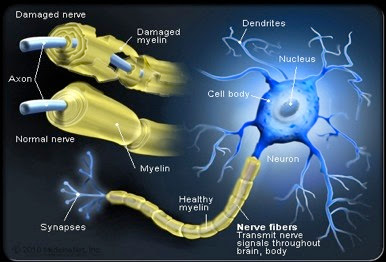New Imaging Technique Evaluates Nerve Damage
ScienceDaily (Sep. 14, 2011) — A new imaging technique could help doctors and researchers more accurately assess the extent of nerve damage and healing in a live patient.
Researchers at Laval University in Québec and Harvard Medical School in Boston aimed lasers at rats' damaged sciatic nerves to create images of the individual neurons' insulating sheath called myelin. Physical trauma, repetitive stress, bacterial infections, genetic mutations, and neurodegenerative disorders such as multiple sclerosis can all cause neurons to lose myelin. The loss slows or halts the nerve's transmission of electrical impulses and can result in symptoms such as numbness, pain, or poor muscle control.
Using their images of neurons, the researchers measured the thickness of the myelin at different locations and times after the rats' sciatic nerve was damaged. Two weeks after injury the nerve's myelin covering had thinned considerably, but at four weeks the nerve had begun to heal.
Traditionally, researchers could only obtain such myelin measurements by removing the nerve and slicing it into thin layers, a technique whose destructive nature prevented it from being used to evaluate nerve injuries in living patients. The new imaging method, described in the September issue of the Optical Society's (OSA) open-access journal Biomedical Optics Express, holds promise as a diagnostic tool for doctors treating nerve damage or degenerative diseases, the researchers write.
Story Source: The above story is reprinted (with editorial adaptations by ScienceDaily staff) from materials provided by Optical Society of America, via EurekAlert!, a service of AAAS.
http://www.sciencedaily.com/releases/2011/09/110913103211.htm

No comments:
Post a Comment
All comments welcome but advertising your own service or product will unfortunately result in your comment not being published.